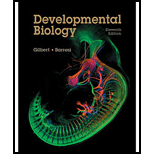
Concept explainers
To review:
During the CNS development whether oligodendrocyte wrapping is essential for neuronal survival or not, and the targeting of synaptic partners is regulated by astroglial cells or not. Also explain whether microglia help “scult” the brain during the development.
Introduction:
Glia also known as glial cells or neuroglia. These are the non neuronal cells present in the central nervous system and peripheral nervous system. Three types of glial cells are present in the central nervous system, named as oligodendrocytes, astroglia and microglia. The transmission of information in neurons takes place via the electric impulses that travel from one part of the body to another along the axons. These cells are important in maintaining the homeostasis and protection of neurons.
Explanation of Solution
Oligodendrocytes are the important glial cells which provide the insulation to axons in central nervous system. This insulation process prevents the dispersal of the electric signal and also enhance the conduction towards the target cells. The wrapping process involves the generation of mylein sheath by the oligodendrocytes. This mylein sheath is 80% lipid and 20% protein. The presence of mylein sheath is essential for the proper functioning of nerve cells. This mylein wrapping also leads to the longevity in axons for decades.
Astroglial cells named because of their “star shape”. These cells are most abundant cells present in the brain and regulates the electrical impulse transmission within the brain. The crucial role of astrocytes, is maintainence of proper health and function of the nervous system by providing the
Microglia also play an important role as “immune cells” of the central nervous system. These cells perform their function by the process of phagocytosis and behave like the macrophages. Thus essential to maintain a good health of the CNS.
Thus it is concluded that oligodendrocyte wrapping is essential for neuronal survival, the targeting of synaptic partners is regulated by astroglial cells and microglia helps in “scult” the brain during the development.
Want to see more full solutions like this?
Chapter 14 Solutions
Developmental Biology
- Please help with these two questions, thank you so much!!!arrow_forwardWork 2. Scheme of the nerve cell structure. Indicate the structural components of Indicate the functional areas of the neuron the neuron: 1. dendrites, a. the synaptic input area, 2. the body (pericarion), b. area of synthesis of substances, including mediator, 3. axon hillock, c. the place where the action potential is generated, 4. axon, 5. axon branches, d. the action potential propagation section, 6. axon terminal e. the mediator transport site, f. area of synaptic contacts with other cells.arrow_forwardhelp ASAP please ?? regardsarrow_forward
- Need help with all parts of 2!arrow_forward! Required information 30s REFLEX ARC Skin- Stimulation of a sensory receptor results in the transmission of an afferent impulse along the axon of a sensory neuron. These axons end in the spinal cord. In most cases, the impulse will then travel through an interneuron within the spinal cord to synapse with a motor neuron. ▶ CO 0:00 1:09 A simple spinal reflex typically involves how many neurons? Multiple Choice 4 Sensory receptor 2 3 1x Carrow_forwardPlease help with these two questions, thank you so much!!!arrow_forward
- Paper link - https://www.jneurosci.org/content/40/8/1756.long Neuronal Mitochondria Modulation of LPS-Induced Neuroinflammation What is LPS (not just what does it stand for)? Why is it used as a model for neuroinflammation? Describe microglia: where are they found, what role do they play, why can't that role be carried out the same way it is in the rest of the body? Mitofusin2 (Mfn2) is a mitochondrial protein. What is its apparent role? Can you think of a reason why overexpression could be protective against a stress? Is it reasonable that overexpression of this gene could also cause problems (if so, how)? How did the authors arrange that Mfn2 was only upregulated in the brain and spinal cord of TMFN mice, and not in other tissues of the mice? How do they demonstrate this? Briefly describe the roles of these molecules in immunity/inflammation:IL-1βIL-6IL-10TNFα They all belong to a class of molecules; what is that class called? What evidence do the authors provide that…arrow_forwardNeed help with these questionsarrow_forwardAction Potential of Neurons Worksheet 1. Explain how an action potential and graded potential are different. Where do they occur on a neuron? How long does each last? What kind of gates is each process using? 2. Describe the following in your own words a. resting potential C. hyperpolarization e. threshold 9. 3. What triggers an action potential? What happens to the membrane to trigger an action potential? 4. What is a positive feedback loop? How does a neuron create a positive feedback loop (self- propagation) 5. What is the role of the voltage-gated sodium channels for producing an action potential? 6. What is the role of the voltage-gated potassium channels? 7. What would happen if the voltage gated sodium channels a. Never opened? b. Stayed open longer than normal? 8. What is the absolute refractory period? What is the relative refractory period? Consider the following three diagrams of a nerve cell membrane. They show resting potential, depolarization, and hyperpolarization.…arrow_forward
 Biology: The Dynamic Science (MindTap Course List)BiologyISBN:9781305389892Author:Peter J. Russell, Paul E. Hertz, Beverly McMillanPublisher:Cengage Learning
Biology: The Dynamic Science (MindTap Course List)BiologyISBN:9781305389892Author:Peter J. Russell, Paul E. Hertz, Beverly McMillanPublisher:Cengage Learning Anatomy & PhysiologyBiologyISBN:9781938168130Author:Kelly A. Young, James A. Wise, Peter DeSaix, Dean H. Kruse, Brandon Poe, Eddie Johnson, Jody E. Johnson, Oksana Korol, J. Gordon Betts, Mark WomblePublisher:OpenStax College
Anatomy & PhysiologyBiologyISBN:9781938168130Author:Kelly A. Young, James A. Wise, Peter DeSaix, Dean H. Kruse, Brandon Poe, Eddie Johnson, Jody E. Johnson, Oksana Korol, J. Gordon Betts, Mark WomblePublisher:OpenStax College Biology 2eBiologyISBN:9781947172517Author:Matthew Douglas, Jung Choi, Mary Ann ClarkPublisher:OpenStax
Biology 2eBiologyISBN:9781947172517Author:Matthew Douglas, Jung Choi, Mary Ann ClarkPublisher:OpenStax


